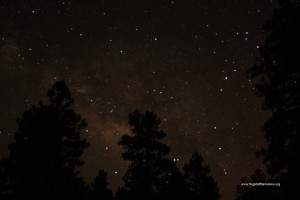Stars in Your Backyard
 Stars In Your Back Yard (STINYBY) is a set of activities designed primarily for Flagstaff students and residents but can easily be used by any student in any community wishing to contribute real data about stars, night vision, and light pollution. These activities were prepared by the Flagstaff Dark Skies Coalition and the Willow Bend Environmental Education Center. For more information, download the STINYBY Teacher’s Guide.
Stars In Your Back Yard (STINYBY) is a set of activities designed primarily for Flagstaff students and residents but can easily be used by any student in any community wishing to contribute real data about stars, night vision, and light pollution. These activities were prepared by the Flagstaff Dark Skies Coalition and the Willow Bend Environmental Education Center. For more information, download the STINYBY Teacher’s Guide.
Activity 2 in the Teachers Guide is the Backyard Star Count. Observers observe a sequence of stars in a designated section of the sky (Ursa Minor, a.k.a. The Little Dipper) and record their observations on a data sheet. If you are interested in initiating a class activity using this guidance, please contact us and we will provide a web-page for on-line data entry and mapping.
Materials:
- A clear night between April and November with no moon. It must be PERFECTLY CLEAR!
- Your activity sheet from school
- Your Data Sheet
- A pencil
- A very faint flashlight with a red filter or a red LED light
- A watch
Methods:
Step 1: Dress warmly and go outside after it’s completely dark. Find a place where you can see all of the Little Dipper. If you can, find a spot where you cannot see any bright lights: no streetlights, lighted signs, neighbors’ porch lights, or brightly lighted windows on homes, including yours! Get comfortable – you might sit in a chair facing North. Protect your eyes from lights! If you see a car’s headlights passing by, cover your eyes!
Step 2: Refer to your watch, and enter the time you went outside (hour and minute) on the Data Sheet. Use the flashlight as little as possible!
Step 3: Find the Little Dipper. Again, use the flashlight as little as possible!
Step 4: Beginning with Polaris, labeled “A” on the Data Sheet, locate all the lettered stars that you can see. As you get higher up the alphabet and to the faintest stars you can see, it will take you some time with each star to decide if you can or can’t see it. For the faintest star you can see, you will only see it some of the time. Take a minute or two to decide, not longer. Using the “Observation 1” table on your Data Sheet, check off all the stars you see. It is important for the observation that you try hard to see as faint as you can, but be scientific and honest! It is also important to use the flashlight just as little as is necessary to help you know where to look – if you use it too much it will ruin your night vision and you will see only bright stars. After you finish this first observation, enter the time (hour and minute) at the top of the Data Sheet table.
Step 5: Repeat Step 4 three more times, each time about five minutes after the previous count. Check off the visible stars on your Data Sheet, and indicate the time that you finish each observation at top of each table.
Step 6: Get to a computer, have a nice cup of hot chocolate, and enter your data online.

